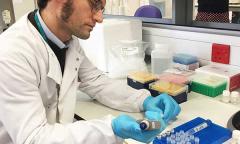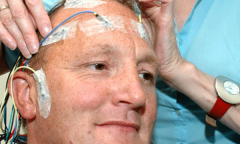Monitoring drug concentrations
1) Dose optimization on the initially prescribed treatment
Measurement of serum concentrations of the initially prescribed AED can be of particular value in the following settings:
(a) whenever, for medical or psychosocial reasons, it is imperative to minimize the risk of seizure recurrence;
(b) in patients receiving phenytoin therapy, because the dose-dependent pharmacokinetics of this drug make it particularly difficult to predict whether a high or low serum concentration has been achieved on the initially prescribed dose;
(c) whenever there are uncertainties in the differential diagnosis of signs or symptoms suggestive of concentration-dependent AED toxicity;
(d) whenever, irrespective of the dosing strategy used, seizure freedom has been achieved and maintained for a sufficient period of time to be confident that dosage has been optimized. In this situation, measuring the serum AED concentration at a standardized sampling time will allow identification of the “individual therapeutic concentration”, which will be valuable to interpret the clinical picture should a change in response occur during further follow-up. When establishing the individual therapeutic concentration, two separate determinations obtained at intervals of months or years will be preferable to a single determination, because they provide an estimate of the variability of the measure.
2) Uncontrolled seizures or suspected toxicity
In patients in whom toxic symptoms are suspected, serum AED concentrations can aid in confirming a diagnosis of AED toxicity, though clinicians should be aware that relatively low concentrations do not necessarily exclude such a diagnosis. Serum AED concentration monitoring can also be useful in differentiating whether poor seizure control is due to insufficient dosing or rather reflects a paradoxical worsening of seizures due to an excessive drug load
The measurement of serum AED concentrations as an aid to the diagnosis of suspected toxicity may also be valuable in patients whose status is difficult to assess clinically, such as young children and patients with mental disability.
In patients with difficult-to-treat epilepsy, determination of serum AED concentrations aids in determining the magnitude of the required dose increment, particularly with drugs showing dose- dependent pharmacokinetics such as phenytoin. These patients may also require multiple drug therapy, and monitoring serum AED concentrations is useful in identifying pharmacokinetic drug interactions and in making compensatory dosage adjustments.
3) Children
Overall, there is a greater need to monitor serum AED concentrations in infants and children, but also a greater uncertainty regarding reference ranges since the quoted ranges are derived almost exclusively from studies in adults.
The pharmacokinetics of AEDs is markedly influenced by age, especially during infancy and childhood and because of shorter elimination half-lives and higher clearance, infants may require a mg/kg dosage that may be 2-3 times higher than that required to achieve the same drug concentration in an adult. Clearance values decrease gradually throughout childhood, but the precise time course of this process is not well established and is characterized by pronounced inter-individual variability. Thus, for any child of any age, dosage requirements are less predictable than in adults and drug concentrations are more likely to be relevant for optimal management. This issue is particularly complex during the neonatal period.
4) Pregnancy
During pregnancy, maternal serum concentrations not only reflect concentrations that determine therapeutic and adverse effects in the woman, but also the extent of drug exposure to the embryo or foetus. Drug concentrations and alterations are therefore of particular importance in this specific situation. Indeed the blood concentrations of many AEDs are decreased (sometimes rapidly) throughout gestation but the extent of this effect varies with different AEDs and between patients. Thus, decreases in serum AED concentration may be insignificant in some patients and pronounced in others who may require dosage adjustments to maintain seizure control. Monitoring AED concentrations regularly during pregnancy is recommended.
5) Elderly
Suboptimal compliance such as under-dosing, over-dosing, missed doses, or make-up doses are common in older patients and alter serum AED concentrations and, potentially, clinical response. TDM is useful in identifying non-compliance, but caution must be exercised because age-related alterations in absorption and protein binding mimic the effect of non-compliance on serum AED concentrations. Typically, the elderly are prescribed many different drugs and thus the potential for pharmacokinetic interactions to occur is substantial and TDM offers a valuable adjunct in optimising dosage regimens.
6) Changes in AED formulation
When an AED formulation is changed, eg when switching from a brand formulation to a generic formulation or between different generic formulations, measuring the serum concentration of the AED before and after the change may help in identifying potential alterations in steady-state drug concentrations resulting from differences in bioavailability.
7) Pathological states
The absorption, distribution, and elimination of AEDs can be markedly affected by the changes in homeostasis caused by various illnesses, including hepatic or renal failure, infections, burns, stroke, cardiac failure, and other conditions. In addition to the alterations caused by the pathological state per se, drugs used to treat these conditions can cause interactions that also affect AED concentrations. The monitoring of serum AED concentrations is valuable in helping the clinician to identify these pharmacokinetic changes and enabling him or her to make dose adjustments whenever appropriate.
8) Pharmacokinetic interactions
AEDs, as a therapeutic class of drugs, are associated with more drug-drug pharmacokinetic interactions than any other drug class. These interactions can occur between AEDs and between AEDs and other non-epilepsy drugs that are used to treat concurrent disorders. An important objective of AED treatment is to anticipate and minimize the risks of clinically relevant pharmacokinetic interactions. These interactions primarily occur at the metabolic level and are attributable to either enzyme induction or enzyme inhibition. Enzyme induction results in a decrease in serum AED concentrations potentially resulting in seizure breakthrough whilst enzyme inhibition results in an increase in serum AED concentrations potentially resulting in toxicity. TDM can be used to guide AED dosage strategies in this setting.
For further reading: Patsalos PN, Berry DJ, Bourgeois BFD, et al. Antiepileptic drugs – Best practice guidelines for therapeutic drug monitoring: A position paper by the Subcommission on Therapeutic Drug Monitoring, ILAE Commission on Therapeutic Strategies. Epilepsia 2008; 49: 1239-1276.
Patsalos PN, Spencer EP and Berry DJ. Therapeutic Drug Monitoring of Antiepileptic Drugs in Epilepsy: A 2018 Update. Ther Drug Monit 2018; 40:526-548.
Therapeutic Drug Monitoring (TDM)
Therapeutic drug monitoring (TDM) is an area of clinical chemistry that specialises in measuring medication levels (concentrations) in patients, usually through blood samples but also through saliva samples.
Having an electroencephalograph (EEG) at our EEG Telemetry Unit
The following information should tell you everything you need to know about having an EEG at our EEG Telemetry Unit.


